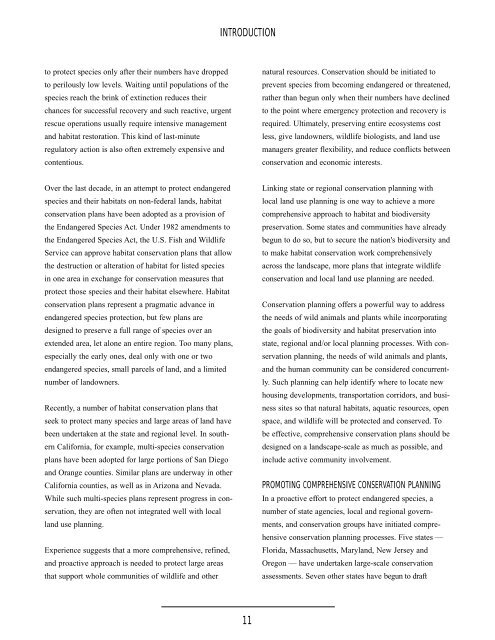Integrating Land Use Planning and Biodiversity - Defenders of Wildlife
Integrating Land Use Planning and Biodiversity - Defenders of Wildlife
Integrating Land Use Planning and Biodiversity - Defenders of Wildlife
Create successful ePaper yourself
Turn your PDF publications into a flip-book with our unique Google optimized e-Paper software.
INTRODUCTION<br />
to protect species only after their numbers have dropped<br />
to perilously low levels. Waiting until populations <strong>of</strong> the<br />
species reach the brink <strong>of</strong> extinction reduces their<br />
chances for successful recovery <strong>and</strong> such reactive, urgent<br />
rescue operations usually require intensive management<br />
<strong>and</strong> habitat restoration. This kind <strong>of</strong> last-minute<br />
regulatory action is also <strong>of</strong>ten extremely expensive <strong>and</strong><br />
contentious.<br />
natural resources. Conservation should be initiated to<br />
prevent species from becoming endangered or threatened,<br />
rather than begun only when their numbers have declined<br />
to the point where emergency protection <strong>and</strong> recovery is<br />
required. Ultimately, preserving entire ecosystems cost<br />
less, give l<strong>and</strong>owners, wildlife biologists, <strong>and</strong> l<strong>and</strong> use<br />
managers greater flexibility, <strong>and</strong> reduce conflicts between<br />
conservation <strong>and</strong> economic interests.<br />
Over the last decade, in an attempt to protect endangered<br />
species <strong>and</strong> their habitats on non-federal l<strong>and</strong>s, habitat<br />
conservation plans have been adopted as a provision <strong>of</strong><br />
the Endangered Species Act. Under 1982 amendments to<br />
the Endangered Species Act, the U.S. Fish <strong>and</strong> <strong>Wildlife</strong><br />
Service can approve habitat conservation plans that allow<br />
the destruction or alteration <strong>of</strong> habitat for listed species<br />
in one area in exchange for conservation measures that<br />
protect those species <strong>and</strong> their habitat elsewhere. Habitat<br />
conservation plans represent a pragmatic advance in<br />
endangered species protection, but few plans are<br />
designed to preserve a full range <strong>of</strong> species over an<br />
extended area, let alone an entire region. Too many plans,<br />
especially the early ones, deal only with one or two<br />
endangered species, small parcels <strong>of</strong> l<strong>and</strong>, <strong>and</strong> a limited<br />
number <strong>of</strong> l<strong>and</strong>owners.<br />
Recently, a number <strong>of</strong> habitat conservation plans that<br />
seek to protect many species <strong>and</strong> large areas <strong>of</strong> l<strong>and</strong> have<br />
been undertaken at the state <strong>and</strong> regional level. In southern<br />
California, for example, multi-species conservation<br />
plans have been adopted for large portions <strong>of</strong> San Diego<br />
<strong>and</strong> Orange counties. Similar plans are underway in other<br />
California counties, as well as in Arizona <strong>and</strong> Nevada.<br />
While such multi-species plans represent progress in conservation,<br />
they are <strong>of</strong>ten not integrated well with local<br />
l<strong>and</strong> use planning.<br />
Experience suggests that a more comprehensive, refined,<br />
<strong>and</strong> proactive approach is needed to protect large areas<br />
that support whole communities <strong>of</strong> wildlife <strong>and</strong> other<br />
Linking state or regional conservation planning with<br />
local l<strong>and</strong> use planning is one way to achieve a more<br />
comprehensive approach to habitat <strong>and</strong> biodiversity<br />
preservation. Some states <strong>and</strong> communities have already<br />
begun to do so, but to secure the nation's biodiversity <strong>and</strong><br />
to make habitat conservation work comprehensively<br />
across the l<strong>and</strong>scape, more plans that integrate wildlife<br />
conservation <strong>and</strong> local l<strong>and</strong> use planning are needed.<br />
Conservation planning <strong>of</strong>fers a powerful way to address<br />
the needs <strong>of</strong> wild animals <strong>and</strong> plants while incorporating<br />
the goals <strong>of</strong> biodiversity <strong>and</strong> habitat preservation into<br />
state, regional <strong>and</strong>/or local planning processes. With conservation<br />
planning, the needs <strong>of</strong> wild animals <strong>and</strong> plants,<br />
<strong>and</strong> the human community can be considered concurrently.<br />
Such planning can help identify where to locate new<br />
housing developments, transportation corridors, <strong>and</strong> business<br />
sites so that natural habitats, aquatic resources, open<br />
space, <strong>and</strong> wildlife will be protected <strong>and</strong> conserved. To<br />
be effective, comprehensive conservation plans should be<br />
designed on a l<strong>and</strong>scape-scale as much as possible, <strong>and</strong><br />
include active community involvement.<br />
PROMOTING COMPREHENSIVE CONSERVATION PLANNING<br />
In a proactive effort to protect endangered species, a<br />
number <strong>of</strong> state agencies, local <strong>and</strong> regional governments,<br />
<strong>and</strong> conservation groups have initiated comprehensive<br />
conservation planning processes. Five states —<br />
Florida, Massachusetts, Maryl<strong>and</strong>, New Jersey <strong>and</strong><br />
Oregon — have undertaken large-scale conservation<br />
assessments. Seven other states have begun to draft<br />
11
















![[PDF] Community Development Toolkit - CommDev](https://img.yumpu.com/48616495/1/184x260/pdf-community-development-toolkit-commdev.jpg?quality=85)
